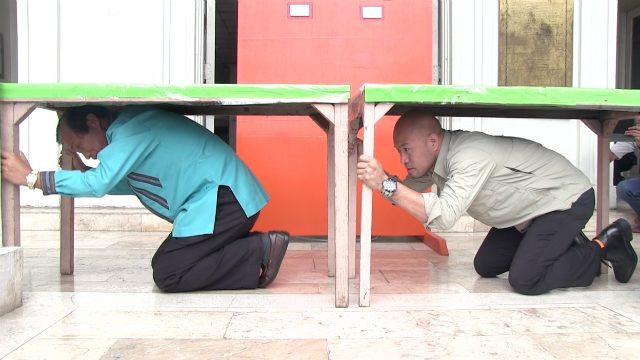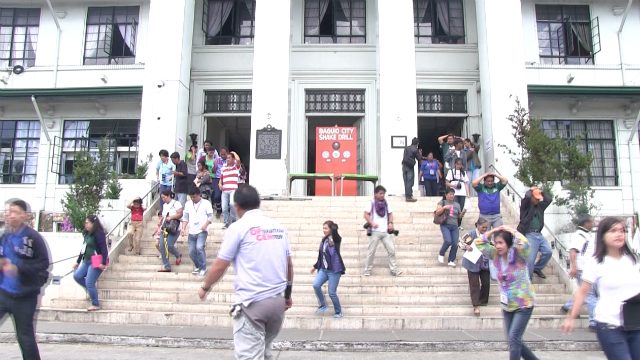SUMMARY
This is AI generated summarization, which may have errors. For context, always refer to the full article.

BAGUIO CITY, Philippines – Sirens ring across the city hall as employees hastily evacuate to open spaces. Detainees from a nearby police station are moved to a safer place as ambulances rush to different villages.
For some long-time Baguio residents, this scene is all too familiar. But they know it can be worse.
Twenty-six years after a 7.8-magnitude earthquake ravaged the city, Baguio conducted its first ever city-wide drill on Thursday, March 31. All of the city’s barangays (villages), public offices, schools, and some private establishments participated in the drill that started at 10:30 am.
According to Baguio City Mayor Mauricio Domogan, the drill aims to instill disaster preparedness in the consciousness of residents. (WATCH: Project MOVE: Preparing for earthquakes)
“Calamities strike without prior notice. That’s why there’s no substitute to being prepared. What we did now is important to remind residents that disasters can happen any time,” he said.
Domogan added: “We should know what to do when it happens. Let us learn our lesson during the killer earthquake of July 16, 1990. So many people then did not know what to do.”
Remembering the killer quake
Domogan, who was a city councilor in 1990, remembered vividly what happened on that fateful July afternoon.
While parking his car after he arrived at his law office, he saw buildings across the road shaking.
“My staff ran to the open area. That’s where we waited for the first shaking to stop. Then, the aftershocks came,” Domogan said.
Then, Domogan added, the rain came, which made the rescue operations difficult.
“From outside the Baguio Park Hotel, you can hear the cries of help of those people buried inside. Your heart will bleed because you couldn’t do anything,” he recalled.
The epicenter of the earthquake that hit Northern and Central Luzon was recorded in Nueva Ecija, and the shaking lasted for about a minute. In Baguio City, several structures collapsed, burying people alive. Some establishments destroyed included hotels like the Hyatt Terraces Plaza, Nevada Hotel, Baguio Hilltop Hotel, Baguio Park Hotel, and FRB Hotel.
Domogan said the quake drill is an important step so that the 1990 tragedy won’t happen again. (READ: Remembering the 1990 Luzon Earthquake)
“We are going to institutionalize our earthquake and drills for calamities. It’s very hard to be caught flatfooted when calamities strike. If we look at Geology, there are no big fault lines passing through our city. There are a few small lines but just the same, we are prone to strong typhoons, landslides, and quakes,” he concluded.
#BaguioCityShakeDrill
The city government and the Office of Civil Defense (OCD) – Cordillera made social media an integral part of their drill. Residents were asked to pose their duck, cover, and hold pictures on Twitter with the hashtag #BaguioCityShakeDrill.
It’s the #BaguioCityShakeDrill and the Victory Liner Passenger Center’s open area is a safe zone. #MicrotelBaguio pic.twitter.com/A5h6W4nJ8L
— Microtel Philippines (@MicrotelPH) March 31, 2016
EARLIER: UC emergency response team during the rescue simulation. #BaguioCityShakeDrill @MovePH @ocd_car pic.twitter.com/fgZakqyJVX
— UC-BCF (@UCJaguars) March 31, 2016
Sm city baguio joins the #baguiocityshakedrill pic.twitter.com/ky3TkhmiVG
— Dawn Fernando (@dawnlyndelle) March 31, 2016
BJMP detainees were evacuated out of their cells for the #BaguioCityShakeDrill . pic.twitter.com/IosdeElI5e
— Martin Aguda Jr. (@m1ready) March 31, 2016
MovePH’s disaster information platform Agos, which is powered by eBayanihan, was also used to map the simultaneous drills conducted across the city.
Is Baguio prepared?

According to OCD-Cordillera Chief Alex Uy, while the city has made long strides in disaster preparedness, there is still a lot to be done.
“Baguio has invested a lot in disaster risk reduction (DRR) since 1990. They now have the systems, the manpower, the equipment. But what we want to tell the public is that the DRR investment should be directed to addressing the worse case scenarios,” Uy told Rappler.
One of the gaps, Uy added, was the evacuation plan for the residents.
“Looking at the map of Baguio City, there are very few vacant spaces left. How do we use the parks as evacuation areas?” he noted.
Compared to 1990, the city has also become more populated and urbanized, which increased Baguio’s vulnerability.
“If we use the formula of DRR, the community’s vulnerability increases when the capacity to respond is low. Baguio’s local government is investing but they need to strengthen their capacity to respond to the worse case scenario so that the vulnerability will decrease,” Uy said.
Is Baguio prepared for an earthquake? While this can only be tested when a real disaster strikes, one thing is for certain: The city of pines has learned its lessons from 1990 and hopes not to commit the same mistakes. – Rappler.com
Add a comment
How does this make you feel?
There are no comments yet. Add your comment to start the conversation.